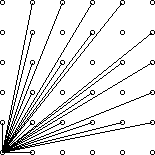题目:
Description
A lattice point (x, y) in the first quadrant (x and y are integers greater than or equal to 0), other than the origin, is visible from the origin if the line from (0, 0) to (x, y) does not pass through any other lattice point. For example, the point (4, 2) is not visible since the line from the origin passes through (2, 1). The figure below shows the points (x, y) with 0 ≤ x, y ≤ 5 with lines from the origin to the visible points.

Write a program which, given a value for the size, N, computes the number of visible points (x, y) with 0 ≤ x, y ≤ N.
Input
The first line of input contains a single integer C (1 ≤ C ≤ 1000) which is the number of datasets that follow.
Each dataset consists of a single line of input containing a single integer N (1 ≤ N ≤ 1000), which is the size.
Output
For each dataset, there is to be one line of output consisting of: the dataset number starting at 1, a single space, the size, a single space and the number of visible points for that size.
Sample Input
4 2 4 5 231
Sample Output
1 2 5 2 4 13 3 5 21 4 231 32549
一道运用欧拉函数便可以直接算出来的水题:
以下是ac代码:
#include<iostream>
using namespace std;
int main()
{
int k;
//欧拉函数打表
int ol[1000+10]={0};
ol[1]=1;
for(int i=2;i<1005;i++)
if(!ol[i])
for(int j=i;j<1005;j+=i)
{
if(!ol[j]) ol[j]=j;
ol[j]=ol[j]/i*(i-1);
}
cin>>k;
for(int l=0;l<k;l++)
{
int n,sum=0;
cin>>n;
for(int i=1;i<=n;i++)
sum+=ol[i];
sum=sum*2+1;
cout<<l+1<<" "<<n<<" "<<sum<<endl;
}
return 0;
}





 本文提供了一种使用欧拉函数解决计算指定范围内可见点数量的算法,并通过C++代码实例详细解释了实现过程。适用于对算法优化和数论问题感兴趣的开发者。
本文提供了一种使用欧拉函数解决计算指定范围内可见点数量的算法,并通过C++代码实例详细解释了实现过程。适用于对算法优化和数论问题感兴趣的开发者。
















 3万+
3万+

 被折叠的 条评论
为什么被折叠?
被折叠的 条评论
为什么被折叠?








